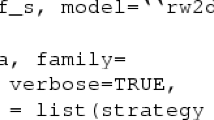Abstract
Recently, public health professionals and other geostatistical researchers have shown increasing interest in boundary analysis, the detection or testing of zones or boundaries that reveal sharp changes in the values of spatially oriented variables. For areal data (i.e., data which consist only of sums or averages over geopolitical regions), Lu and Carlin (Geogr Anal 37: 265–285, 2005) suggested a fully model-based framework for areal wombling using Bayesian hierarchical models with posterior summaries computed using Markov chain Monte Carlo (MCMC) methods, and showed the approach to have advantages over existing non-stochastic alternatives. In this paper, we develop Bayesian areal boundary analysis methods that estimate the spatial neighborhood structure using the value of the process in each region and other variables that indicate how similar two regions are. Boundaries may then be determined by the posterior distribution of either this estimated neighborhood structure or the regional mean response differences themselves. Our methods do require several assumptions (including an appropriate prior distribution, a normal spatial random effect distribution, and a Bernoulli distribution for a set of spatial weights), but also deliver more in terms of full posterior inference for the boundary segments (e.g., direct probability statements regarding the probability that a particular border segment is part of the boundary). We illustrate three different remedies for the computing difficulties encountered in implementing our method. We use simulation to compare among existing purely algorithmic approaches, the Lu and Carlin (2005) method, and our new adjacency modeling methods. We also illustrate more practical modeling issues (e.g., covariate selection) in the context of a breast cancer late detection data set collected at the county level in the state of Minnesota.
Similar content being viewed by others
References
Banerjee S, Gelfand AE and Sirmans CF (2003). Directional rates of change under spatial process models. J Am Stat Assoc 98: 946–954
Banerjee S, Carlin BP and Gelfand AE (2004). Hierarchical modeling and analysis for spatial data. Chapman & Hall, Boca Raton, FL
Besag J (1974). Spatial interaction and the statistical analysis of lattice systems (with discussion). J R Stat Soc Ser B 36: 192–236
Besag J (1986). On the statistical analysis of dirty pictures. J R Stat Soc Ser B 48: 259–302
Best NG, Waller LA, Thomas A, Conlon EM and Arnold RA (1999). Bayesian models for spatially correlated diseases and exposure data (with discussion). In: Bernardo, JM (eds) Bayesian statistics, Vol 6, pp 131–156. Oxford University Press, Oxford
Carlin BP and Banerjee S (2003). Hierarchical multivariate CAR models for spatio-temporally correlated survival data (with discussion). In: Bernardo, JM (eds) Bayesian statistics, Vol 7, pp 45–63. Oxford University Press, Oxford
Carlin BP and Louis TA (2000). Bayes and empirical Bayes methods for data analysis. Chapman and Hall/CRC Press, Boca Ration, FL
Clayton DG and Kaldor JM (1987). Empirical Bayes estimates of age-standardized relative risks for use in disease mapping. Biometrics 43: 671–681
Geman S and Geman D (1984). Stochastic relaxation, Gibbs distributions and the Bayesian restoration of images. IEEE Trans Pattern Anal Mach Intell 6: 721–742
Harville DD (1997). Matrix algebra from a statistician’s perspective. Springer-Verlag, New York
Helterbrand JD (1996). One-pixel-wide closed boundary identifications. IEEE Trans Image Process 5: 780–783
Helterbrand JD, Cressie N and Davidson JL (1994). A statistical approach to identifying closed object boundaries in images. Adv Appl Probab 26: 831–854
Hodges JS, Carlin BP and Fan Q (2003). On the precision of the conditionally autoregressive prior in spatial models. Biometrics 59: 316–322
Hoff PD, Raftery AE and Handcock MS (2002). Latent space approaches to social network analysis. J Am Stat Assoc 97: 1090–1098
Lu H and Carlin BP (2005). Bayesian areal wombling for geographical boundary analysis. Geogr Anal 37: 265–285
Oden NL, Sokal RR, Fortin M-J and Goebl H (1993). Categorical wombling: detecting regions of significant change in spatially located categorical variables. Geogr Anal 25: 315–336
Short M, Carlin BP and Bushhouse S (2002). Using hierarchical spatial models for cancer control planning in Minnesota (United States). Cancer Causes Control 13: 903–916
Spiegelhalter DJ, Best DG, Carlin BP and van der Linde A (2002). Bayesian measures of model complexity and fit (with discussion). J R Stat Soc Ser B 64: 583–639
Thomas AJ and Carlin BP (2003). Late detection of breast and colorectal cancer in Minnesota counties: an application of spatial smoothing and clustering. Stat Med 22: 113–127
Wang YJ and Wong GY (1987). Stochastic blockmodels for directed graphs. J Am Stat Assoc 82: 8–19
Womble W (1951). Differential systematics. Science 114: 315–322
Author information
Authors and Affiliations
Corresponding author
Rights and permissions
About this article
Cite this article
Lu, H., Reilly, C.S., Banerjee, S. et al. Bayesian areal wombling via adjacency modeling. Environ Ecol Stat 14, 433–452 (2007). https://doi.org/10.1007/s10651-007-0029-9
Received:
Revised:
Published:
Issue Date:
DOI: https://doi.org/10.1007/s10651-007-0029-9




